The secret to this gluten-free sourdough bread is the flour mix. The flour mix balances the protein with stickiness and water absorption. The result is a pretty amazing loaf of bread.
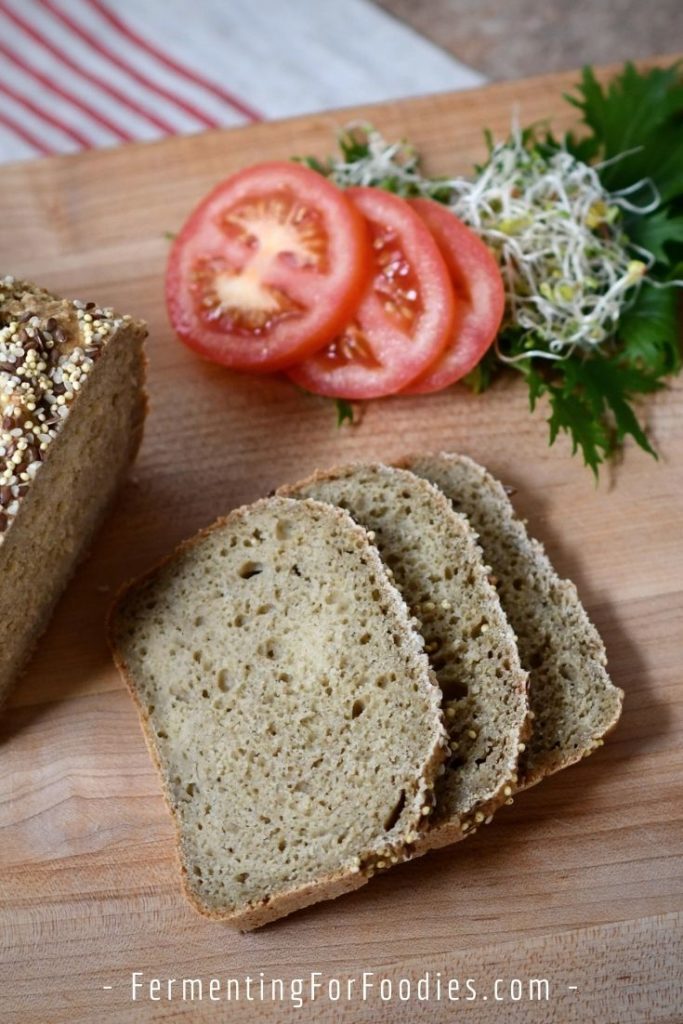
I used to miss sandwiches… The hardest part of being gluten-free was walking by a local deli and wishing I could eat one of their fully-loaded paninis. Instead, I was stuck with bread that had the taste and texture of styrofoam…
until now…
Now I make sandwiches with my delicious gluten-free sourdough bread and enjoy every bite!
How to use this recipe
The secret to a really amazing loaf of gluten-free bread is:
- Sourdough starter: If you don’t already have a sourdough starter, then you will need to start making one a few days before baking this bread. Here’s my post on creating a Sourdough Starter. If you’re new to sourdough, I recommend using buckwheat or teff flour which both ferment really well.
- The right mix of flours: Everyone has their favorite flours; however, it’s important to use the right mix of starches and flours to make a really good loaf of gluten-free bread. Either buy store-bought bread flour or use my recipe to create your own.
- Binders: This recipe uses eggs and psyllium husks for the binders. You could replace the psyllium husks with equal amounts of ground flaxseed or chia seeds.
- Eggs: Eggs are a big part of the structure in this recipe. I haven’t tried replacing them with vegan alternatives, though some readers have successfully done that (check out the comments below). If eggs are an issue, then I recommend my gluten-free, vegan sourdough bread recipe. It’s every bit as delicious as this bread. Though I designed it to be more of a dinner loaf than a sandwich loaf.
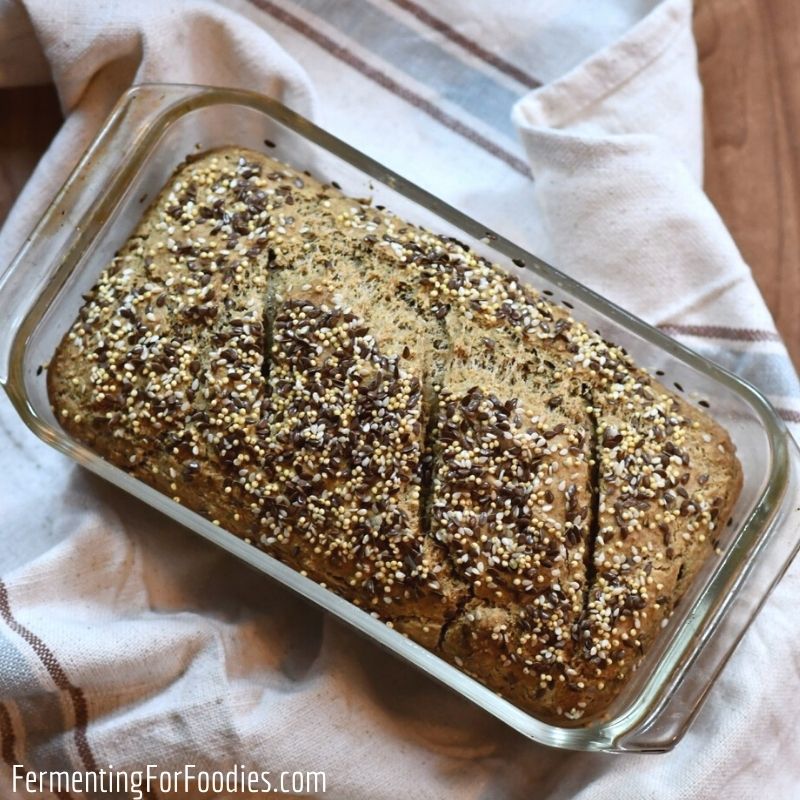
Amazing Gluten Free Bread
Looking for an ABSOLUTELY AMAZING gluten-free sourdough bread recipe? This loaf has the perfect taste and texture for sandwiches and toast.
- Prep Time: 30 minutes
- Cook Time: 1 hour
- Total Time: 1 hour 30 minutes
- Yield: 1 loaf 1x
- Category: Bread
- Method: Sourdough
- Diet: Gluten Free
Ingredients
Sourdough Ferment
- 2 cups of active gluten-free sourdough starter
- 1 cup of filtered water (chlorine-free)
- 2 1/2 cups of gluten-free bread flour mix (see notes)
Remaining Ingredients
- 3 eggs
- 1 tsp salt
- 1 tsp baking soda
- 1/4 cup psyllium husk (whole or powdered)
Instructions
- Mix the sourdough starter with the additional water and flour, and leave it somewhere warm to ferment for 1-12 hours. This is important to fully hydrate the flour. The sourdough starter also helps to breakdown the complex carbs, improving the taste and texture of this bread. The mixture will be quite dry, just cover with a moistened tea towel to prevent it from crusting.
- When you are ready to bake bread, preheat the oven to 350 F.
- Crack the eggs into the sourdough ferment and mix everything together. The sourdough may be quite stiff, so you will really need to beat the eggs into it. Then add the salt and baking soda, followed by the psyllium husk. Stir well to combine. Psyllium husk takes 5 minutes to fully hydrate, so let the batter rest.
- Scrape the batter into a well-oiled loaf pan.
- The acidic sourdough will cause the baking soda to start acting immediately, so allow it to rise for only 30 minutes before baking.
- Bake at 350F for 55-65 min (until cooked through and browning).
Notes
- For this recipe, you will need an active sourdough starter and a good bread flour mix.
- The batter for this bread needs to be baked in a form. Depending on the shape that you want, you can bake this bread in a loaf tin
, or on a baguette pan
. I also like using a cast iron dutch oven to make a boule shape.
- Allow to cool completely before slicing.
- I like sprinkling the top of my bread with a mixture of sesame, flax and millet seeds. It adds a bit of flavour and crunch.
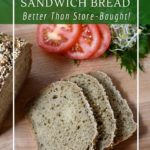
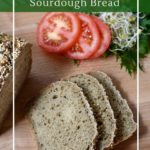
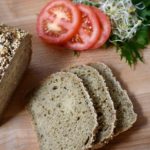
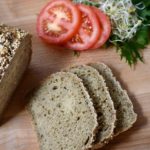
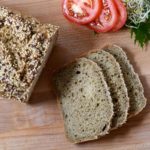
Hi emillie! I’ve tried this recipe a few times now, and I’ve noticed a couple things — you suggest to mix the psyllium with water first, I find it gets way too clumpy! And the clumps are real hard to get out. A psyllium sprinkle then add extra water to the bread mix is better. Also, I find 400 the whole time is too hot. It made my loaves too hard on the outside and gummy on the inside. I haven’t found the best temp yet…maybe 400 for the first 15min then 375 for the rest? And lastly! You used to have a gf sourdough on your site with just buckwheat and oat flour, no psyllium and eggs…I can’t find it?!? I’d like to try it again! Anyway, happy baking!
Good advice around the psyllium husk! I will try that today! I may have deleted the straight oat/buckwheat bread recipe. I had WAY too many GF bread recipes on my blog and was trying to trim things up, and that was a recipe that didn’t make a great loaf of bread.
I suspect that baking temperature might be oven specific. I wouldn’t be surprised if my oven was a bit cool… everything takes forever to bake! I’ll look into it. Happy harvest season!
The recipe calls for 3 cups, but directions only mentionb2 cups. Have I missed something?
Two cups go into your initial starter… then you add another cup in for the final rise with the other flours. But you’re right… I didn’t write it clearly. I will fix today! Thanks!
I don’t see what Mena was commenting about. Where does it talk about three cups? (And three cups of what?). Has the recipe changed since her comment?
Yes, I rewrote it to be more clear after she made her comment.
Hi Emillie, I don’t see anything about a third cup of starter in the second stage of baking this bread, after the first ferment. Can you clarify? Should I add a third cup into the egg mixture? Thanks!
Hi Adina,
I rewrote the recipe so that all the flour and water went into the initial feed. 🙂 Originally, there was a small feed to get the starter really active before putting together the bread. But it was just getting too confusing, so I rewrote the recipe. I’ve since tested it a ton of times, so it should work exactly as written.
Cheers, Emillie
Hi Emillie – this was a really easy recipe to follow and the texture and look are great; however I’m really disliking the flavour and smell of physillium husk – you suggest chia seeds and flaxseeds (or xanthum gum) as substitutes. Are the quantities the same? Warmest regards, Judy
Interesting… I’ve never noticed the flavour of the psyllium husk. Xanthan is probably the best replacement. I would use 4 tsp of xanthan in the recipe. If you want to replace with chia or ground flax, then stick with the 1/4 cup.
Do you make your own blend or buy one? What is your preferred blend?
I make my own! Here’s a link to my recipe: https://www.fermentingforfoodies.com/archives/984
Love this recipe, great flavor and texture. Made it vegan by subbing 2/3 cup of applesauce unsweetened and 1 flax egg. If you live at high altitude, consider lowering the temperature and lessening cook time. I cooked my loaf at 375 for 50 minutes and the edges and bottom were overcooked. Next week I will begin checking loaf at 30 minutes.
Many blessings to Emillie and the rest of you 🙂
What a great vegan suggestion! I’ve been trying to make a decent GF vegan loaf… but never came up with anything very good. I’ll try this next time.
Hi Emillie
I was searching your website for more info about glutenfree sourdough.
Can you use also sprouted flour for making the bread? Do you use 1 whole grain flour at the time or do you use a mix from different flours?
Thank You
Hi Emillie
I was searching you website for info about glutefree sourdough.
Can you use also sprouted grains in the bread recipe?
Do you use 1 whole grain flour per recipe or a mix of flours?
Thank You
You can use a mix of whole grain flours, sprouted flours, what ever you want! If you use sprouted grain, be sure that it’s fully dry, or you may need to decrease the amount of water you use, as it won’t absorb as much.
Thank You Emillie!
I have used this recipe a few times now with minor adjustments to raising time and baking temps. This is the best bread I’ve had in years! I found it to make two very small loaves or one regular size and a few rolls which I baked in a muffin pan.
I added molasses and caraway seeds to one loaf for a beautiful Ryeless Rye bread.
Your tips for flour mixes are highly appreciated as I can not tolerate gums or potato starch so prepared mixes are out for me.
Thank You sincerely, I look forward to checking out your other recipes.
Thank you! I’m going to try your rye-less rye next time. Yum!
Hi, I’m wondering.. do you knead this dough at all? It seemed strange to just mix it and put it in the pan. Also didn’t seem to rise at all.. I’m new to gluten free breads and sourdough in general. Thanks!
Gluten-free bread is quite different from regular bread. The lack of gluten means that kneading doesn’t serve the same purpose (usually to develop the gluten) 🙂 I have a number of different gf recipes. This one uses eggs for the structure and the sourdough is mostly used to acidify the flour so the baking soda causes it to rise in the oven.
If you’re looking for a pure gf sourdough, try this recipe: https://www.fermentingforfoodies.com/gluten-free-and-vegan-sourdough-bread/ However, it’s much more tricky, and you still won’t have much rising before baking… even though the sourdough is what gives it loft.
I’m kind of confused step one says to ferment for 2-12 hours until it’s hydrated. What does that look like? Does that mean it needs at least 2 hrs but can ferment for 12? That’s just a huge range of time.
Thanks!
It depends on your patience. You need at least 2 hours to fully hydrate the flour, and up to 12 hours to build the sourdough culture. The flexibility is so that you can bake when it’s most convenient for you!
Hello,
I’m curious what blend of flours you use to make your gluten free flour?
I usually use oat flour our light buckwheat flour as my base, which I then mix into my GF bread flour mix (tapioca starch, chickpea flour and masa). 🙂 I find rice particularly dry. But otherwise, most flours are tasty!
Hi Emillie,
Thank you for replying to my comment on the sourdough starter page. I tried this recipe with 1/2 cup oat flour, 3/4 cup GF flour mix again Orgran (Maize Starch, Rice Flour, Tapioca Starch, Rice Bran, Vegetable Gum (Thickener): Guar Gum), 1 cup oat starter, batter was incredibly thin. I left it overnight and was just as thin if not thinner due to breakdown. I could basically pour the stuff, is this the consistency to look for? I just thought that it was way too thin so I added an extra 1/4 cup of oats and 3/4 cup of orgran to make it into a paste like consistency. I added the other ingredients inproportion to the extra flour and am baking it now, it seems to be rising in the oven.
Took it out and the inside is gummy in texture with a tough thin crust. It rose well through most of it definitely not a bready texture.
Do you think it would work to not add any extra water and just use the starter? The starter is thin as it is, so adding the extra flour should make it into a dough.
Hi, It sounds like you made quite a bit of changes to the recipe. GF bread is pretty darn tricky, and the psyllium husk absorbs a lot of the liquid. I’m not exactly sure how much flour you would need if you were skipping it. The only alternative to psyllium husk would be ground flax, which is somewhat similar. Also, the eggs are necessary to provide the structure. Cheers, Emillie
could you put this in a bread machine?
could you put this in a bread machine & how haha – I’m new to all of this
I don’t recommend baking GF bread in a bread machine. Unlike regular bread, it doesn’t require kneading. In fact, this recipe is more like a cake than a traditional loaf of wheat bread. Once you mix it you just need to let it rise then bake it. Any additional mixing would actually break down the bubbles and structure.
Hey, I love this recipe and just started my starter! I hope it will turn out well.
Where I live I haven’t been able to find psyllium husk or substitutes, do you have any recipes or ideas of a way I could replace those? Thank you! I love all your posts, they have all been helping me so much!
Hum… so no ground flax or chia seeds… You could add extra flour. It will change the flavour and texture, however, it should still work out. Try adding an extra 1/2 cup of flour instead of the psyllium husk. And I would mix it in with the eggs because if you add it to the sourdough starter it will be too thick. The bread dough is supposed to be a bit more batter-like than dough-like, so don’t add too much flour. Good luck!
Hi. Jjust wondering if I could try this using a gluten free mix such as King Arthur Gluten Free Measure for Measure or Namaste gluten free Perfect Flour Blend instead of the suggested flour mix since I have these mixes on hand and not the ingredients for the suggested flour mix. Thanks,
Absolutely! Any GF bread mix will work well. However, I’ve found the bread to be a bit dry when made with a rice flour blend. Just serve it with an extra smear of butter. 🙂
Hello ,
The recipe worked perfect , except I change the oven temp .
400 for first half fr ( with a lid on the iron pan, and 375 for another 45 min without lid on .
I added walnut and kalamata olives 🙂
How do I add pic here
Emilie thank you . I love ❤️ making my own sourdough gluten free bread .
Thanks! I don’t think my anti-spam software allows pictures. However, you can share it on my facebook page, Pinterest or instagram.
Hi Emillie! I’ve made bread with this recipe 3 times now and love it! Thank you so much, I really missed sandwiches.
Just one question: I want to try cutting the top part just like in the recipe picture, but I don’t know when to do it without ruining the bread. Do you have any tips?
Glad you’re enjoying the bread! We literally eat 2-3 loaves a month. The bread dough is more like a batter, so you can’t slice it before baking. To get nice slices in the top (and to increase expansion) I sometimes remove it from the oven after 20 minutes of baking and just score the top with a sharp knife.
Enjoy, Emillie
Hi Emily,
I made three starters: one brown rice, one sorghum, and one buckwheat. So far, the sorghum is most active, and the buckwheat is barely doing anything (but smells great).
I made the flour mix with buckwheat, chickpea, potato starch and almond flour.
I started a loaf with the sorghum starter, and it is in the phase before adding the eggs. It is VERY stiff (I hope that is okay).
Seems like it would be very helpful if you had pictures of the consistency we should be looking for….
To be clear, I don’t have to wait till it rises much, only to hydrate the flour? I plan to add the eggs after three hours.
Hi Ayla, GF starters are more about smell than the appearance of bubbles. If the buckwheat smells good, then it’s active. It just won’t have big bubbles because of the lack of gluten or carbs to hold those bubbles. More starchy GF flours, like sorghum, will hold bubbles… but it doesn’t mean the other two starters aren’t active.
The bread is quite stiff before adding the eggs and it is mostly to hydrate the flours and feed the starter. However, it doesn’t need to double in size. Again, because it’s a GF bread it won’t be able to rise like wheat bread and the eggs help with the structure. Photos are a good idea. I’ll take a few next time I make this bread. (Which happens about every other week!)
Cheers, Emillie
Hi Emillie, I’m preparing my GF sorghum sourdough starter for this project tomorrow! Very excited to try! I’m curious about adding the eggs and extra ingredients after 1 to 12 hours. Wouldn’t manipulating the dough just ruin all of the nice gas is produced by fermenting?
Sorry for the delayed reply, I took the weekend off. 🙂 Hopefully, your bread was good! GF sourdough isn’t the same as gluten. It develops bubbles but doesn’t have the structure to hold them. The structure is provided by eggs, psyllium husk, etc. You could do a long ferment with all the extra ingredients, but not too long, because of the raw eggs. Enjoy!
Hi Emily!
Thank you for the recipe. I’m curious about one of the ingredients. It seems counterintuitive to add baking soda to a sourdough bread. Doesn’t this deactivate the starter so you lose the ‘sourness’? I’m wondering if others have had success omitting it. I’ve made other sourdough GF breads and have not used baking soda.
Thanks again!
Hi Libby, The baking soda isn’t necessary. However, I’ve found that it helps provide loft. The baking soda reacts with the sourness to provide a second source for the rise. It makes this bread much more sandwich bread-like. However, it shouldn’t affect the sourdough flavor.
Here is one of my recipes that is purely sourdough starter and has no additional rising agents (not even eggs). It’s quite a bit denser but absolutely delicious. Especially if you do the longer rise option. https://www.fermentingforfoodies.com/gluten-free-and-vegan-sourdough-bread/
Cheers! Emillie
Hi. Emillie,
I’m preparing the sourdough to try my first attempt at a gluten free bread, but I’d like to add 2 Tbs of oat bran to give it a bit more fiber (although the psyllium certainly does that). My daughter in law is gluten-free and has commented on how hard it is to find decent GF bread. Im hoping my first try isn’t a flop! I may try this before getting your reply, but I’m guessing I may need to slightly decrease the liquid? This is the flour blend I’ll be using: 1 cup oat flour, 1/2 cup quinoa flour, 1 cup tapioca flour, 1/2 cup masa harina, and 1/2 cup chickpea flour.
Thanks for creating and sharing a GF sourdough option! ~Lori
This recipe is fairly liquidy… it’s not a solid loaf, so I think adding oat bran without adjusting the liquid will be fine. I sometimes add things like millet and flax, without adjusting. This is a great sandwich loaf. I hope she likes it! My other favorite loaf is my GF and vegan bread. It’s very high in fiber, but I love the dense chewy texture… like a rustic loaf. Enjoy!
Wonderful, thank you! I started my oat starter on 11/19/22, so just waiting for it to get sour 🙂 I’ll try the GF Vegan option after this one!
Great! Oat is my favorite for flavor. Don’t expect it to look like wheat sourdough starter. However, it should bubble on the top and smell slightly sour. 🙂
Hello, what a delicious recipe. I placed the flax meal in with the 2 1/2 cups of flour and let it rise 5-6 hours and then added the remaining ingredients. I preheated my oven 400 degrees and warmed up my Dutch cast iron with lid. I placed parchment paper in bottom then pour batter in. Baked with lid on 20 minutes then took lid off baked another 25 minutes. Then wound up baking another 15 minutes until it tapped hollow. Cooled before cutting.
Can this recipe be made in the bread maker?
Hum… I don’t know because I have never tried. I suspect that it should work. However, I think it will turn out better in the oven. Bread makers are designed to knead gluten. This GF bread has a more cake-like batter and doesn’t need any kneading. (Pardon the pun!) Cheers, Emillie
using 3 eggs in one loaf of bread sure sounds like a lot of eggs….i don’t use eggs,
so guess i will use flax or chia meal…..
Eggs are the main binder in this recipe. If you want to avoid them, I recommend this loaf instead. (It’s secretly my favorite, because I love the fiber). https://www.fermentingforfoodies.com/gluten-free-and-vegan-sourdough-bread/ Cheers!